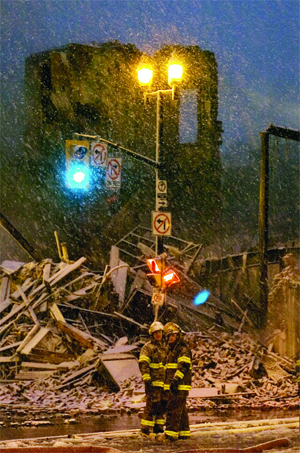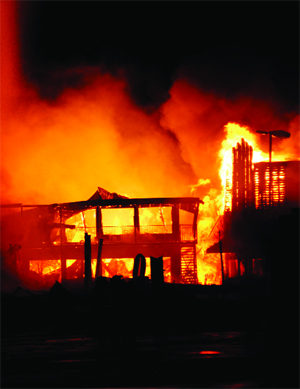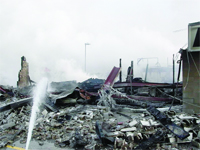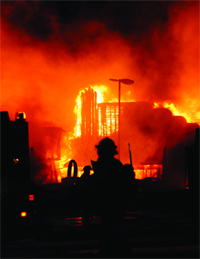
News
Fires raze landmarks: Winter blazes challenge firefighters
COVER STORY
Fires raze landmarks: Winter blazes challenge firefighters
Flames “were blowing straight across like a blow torch”, Chief Mike McWilliam says of the fire that destroyed a tourist strip in Wasaga Beach.
February 26, 2008
By
Laura King
Two massive fires in seven days destroyed historic properties in Wasaga Beach and Barrie, Ont. Hundreds of firefighters – some of whom were called through mutual aid to both blazes – fought the wind-whipped flames that destroyed part of the popular tourist strip in the resort town of Wasaga Beach on Nov. 30-Dec. 1 and the inferno that devastated the historic Wellington Hotel and several other buildings in Barrie on Dec. 7.
At press time, the causes of neither fire had been determined and both were still under investigation.
 |
| Firefighters in Barrie, Ont.,survey the damage after an explosion and fire levelled the historic Wellington Hotel and several other buildings. PHOTO BY BILL SANDFORD |
Wasaga Beach Fire Chief Michael McWilliam shared details of the effort to fight the overnight blaze with Fire Fighting in Canada. We’ll tell the story of the equally challenging Barrie fire in a future issue, once the investigation is completed.
It was the wind that did them in. In his 20 years with the fire service in Wasaga Beach, the resort town on the southern edge of Georgian Bay, Fire Chief Michael McWilliam had never seen wind gusts so strong blowing west to east. “The wind was going straight across from one side of the street to the other,” McWilliam recounts. “So once the flames broke through the roof, they weren’t even going up in the air, they were blowing straight across like a blow torch.”
Mother Nature’s blow torch created a witches’ brew of challenges and concerns for McWilliam, his department and the responders from six other departments who came to help.
Wind-carried embers imperilled any structure within a kilometre downwind of the blaze.
Freezing temperatures created hazardous working conditions and could have posed significant stress to personnel.
Reaching gas and hydro lines and gaining access for crews to safely turn them off was no easy task given the conditions.
There were no injuries in the blaze that started on the west side of Main Street just before 1 a.m. on Nov. 30 and burned throughout morning. The 117 firefighters on scene were unable to save much of the historic pedestrian strip that houses souvenir shops and tourist-friendly attractions. Twenty-one businesses were destroyed.
Damage is estimated to be in the millions and the cause of the fire that started in one of the buildings that was closed up for the winter is under investigation.
Usually, the wind in Wasaga Beach blows north to south but on the night of the blaze the west-to-east gusts were estimated at more than 80 km/h.
The pedestrian strip in Wasaga Beach was an area firefighters knew would pose a significant challenge. “It’s a part of town that primarily comprises older, wooden buildings and we knew that a fire in that area would be a battle, especially with the winds that we get off the bay,” McWilliam said.

|
| High winds challenged firefighters in Wasaga Beach after part of the historic pedestrian strip caught fire on Nov. 30. PHOTO BY BILL SANDFORD |
“The winds couldn’t have been more against us that night, going from west to east. You could actually stand and lean into the wind and it would hold you up.”
The call for a structure fire came in at 00:57:22. Wasaga Beach fire crews responded with seven apparatus.
On arrival, it was confirmed that a commercial building in the pedestrian mall was heavily involved. Extremely high winds coming from the northwest fanned the flames and adjacent buildings quickly caught fire.
Chief McWilliam called for mutual aid from the Township of Tiny Fire Department, the Collingwood Fire Department and the Clearview Fire Department. Three other departments were called for manpower and relief – Oro-Medonte Fire and Emergency Services, Springwater Fire and Emergency Services and Essa Fire Department. The fire chief from Orillia also came to help.
There were 117 firefighters, six fire chiefs and 20 apparatus on scene at the height of the incident. Crews pumped almost two million gallons of water onto the fire, which was brought under control by 7 a.m. but firefighters were on scene most of the day extinguishing hot spots.
McWilliam said that while a pre-plan for the area helped firefighters tackle the blaze some factors were beyond the control of fire officials.
One of the key points in the pre-plan was to try to put a water screen down the centre of the pedestrian walkway to protect buildings on the east or west sides of the strip from fire on the other side. Given the familiar north winds off Georgian Bay that would push the fire along the strip, the plan was to contain the fire to one side of the street and protect the other side. Extreme high winds and the unusual wind direction played havoc with the pre-plan.
“We had embers landing as far as a kilometre away,” McWilliam said. “Big, still red-hot embers, and people calling from that part of town saying that they were concerned that their houses were at risk.”
 |
| Firefighters from six departments worked well into Saturday, Dec. 1, dousing hot spots in Wasaga Beach. PHOTO COURTESY WASAGA BEACH FIRE DEPARTMENT |
McWilliam stationed a mutual-aid crew to watch for windblown embers and make sure they didn’t cause additional fires.
There were some other challenges too.
The freezing temperatures caused water from firefighting efforts to form ice on the fire ground, which created dangerous conditions for everyone. Public works employees were called to the scene to spread sand.
McWilliam said it took some time before workers could isolate the gas supply to the area as they had to locate and dig to reach the shut-off valve.
It was also a challenge to get hydro crews safely onto the scene to cut the power
supply.
Another detail McWilliam said he’ll account for in the future is the town’s water supply. Although firefighters had all the water they needed, the volume of water used to fight the fire taxed the town’s supply and some residents had little water pressure for a brief period the next morning. Ontario Clean Water Agency looks after the water towers for Wasaga Beach and could have been asked to boost the water pressure, McWilliam said.
Still, McWilliam said, from a firefighting point of view, everything went according
to plan.
“This is certainly the largest fire that this municipality has seen and the biggest mutual-aid activation that we’ve ever had. It was incredible to see so many fire departments working together with no real problems, no injuries and no power struggles. Even though I’m new to the position the other fire chiefs just said ‘Chief, what do you need from us?’ I basically sectored off the fire ground and gave each chief an area of responsibility.”

|
| PHOTO BY MATT WHITTLEY |
McWilliam was named fire chief in October and was deputy chief for four years before that. He has lived in the community that boasts the world’s longest freshwater shoreline (14 kilometres) all his life.
He says the mutual-aid system worked very well and officials are reviewing the response to the Wasaga Beach fire and the Barrie fire to see if there is room
for improvement.
According to the website for Wasaga Beach, plans are already underway to rebuild the strip. Indeed, the area was already targeted for renewal as part of a proposed $500-million development.
Still, the fire and the resulting damage was tough for longtime residents like McWilliam, whose family used to run a T-shirt shop on the strip.
“There’s a lot of history there,” he said. “It’s an emotional and sudden loss and to see it go up that way was difficult, even though it was planned for redevelopment.
There wasn’t much we could have done. Our greatest opponent was the wind, and there was no stopping that.”
| THE DEPARTMENT Wasaga Beach Fire Department
|
Print this page
Advertisement
- Back to normal: Why fire departments need back-injury programs
- Head count: Is your accountability program up to PAR?